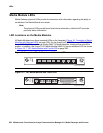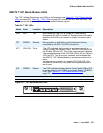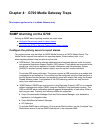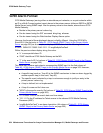
LEDs
298 Maintenance Procedures for Avaya Communication Manager 3.0, Media Gateways and Servers
The supported portion of the LED control message allows software to change the status of the
three standard LEDs on the T1/E1 Media Module faceplate. Power-up and alarm states are the
only conditions where hardware sets the state of the LEDs independent of ANGEL firmware
control.The exceptions to letting software turn off the LEDs are:
● The board is in reset (RED ALM LED remains on)
● A call is up (YELLOW ACT LED remains on while the E1 line is in-frame and at least one
voice/data call is up)
● During board reset initialization testing (GREEN TST LED remains on until initialization
testing is complete)
Note:
Note: For ISDN operation, the Yellow LED will be turned on if ANY port has an active
TDM connection (including the D-channel).
Synchronization
The YELLOW ACT LED on the front of the MM710 Media Module can tell you the status of that
module regarding synchronization.
● If the YELLOW ACT LED is solidly on or off, it has NOT been defined as a synchronization
source. If it is on, one or more channels is active. If it is an ISDN facility, the D-channel will
count as an active channel and will cause the YELLOW ACT LED to be on.
● When the MM710 is driving a clock sync source line to the G700 main clock, the YELLOW
ACT LED does not indicate port activity, but instead indicates that the MM710 is the sync
source by flashing with a regular 3-second period:
● It is on for 2.8 seconds and flashes off for 200 milliseconds if it has been specified as a
sync source and is receiving a signal that meets minimum requirements for the interface.
● If it has been specified as a sync source and is not receiving a signal, or is receiving a
signal that does not meet minimum requirements for the interface, then the YELLOW
ACT LED will be off for 2.8 seconds and flash on for 200 milliseconds.
T1/E1 Initialization
The T1/E1 Media Module LEDs behave in the following manner during initialization. The Angel
provides a visual indication of the Media Module’s status through the three faceplate LEDs:
● During initialization the YELLOW ACT LED is held off, while the RED and GREEN LEDs
are on during the entire initialization sequence.
● Upon power up or reset, if only the RED ALM LED comes on, the Angel processor is dead
or the board is being held permanently in reset.
● Upon completion of the diagnostics and initialization, the GREEN TST LED turns off.
● If the initialization tests fail, the RED ALM LED remains on.
● If the tests all pass, then all LEDs are extinguished until Communication Manager starts
using the Media Module.


















